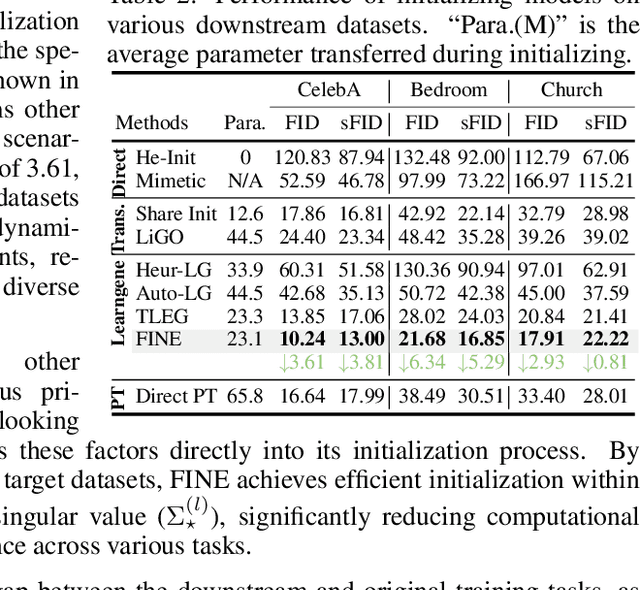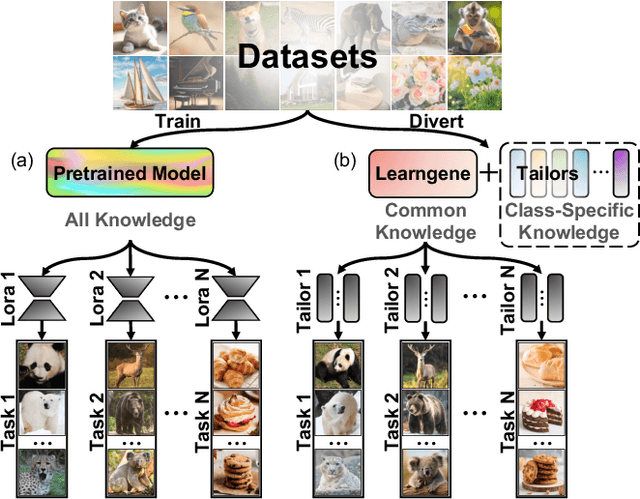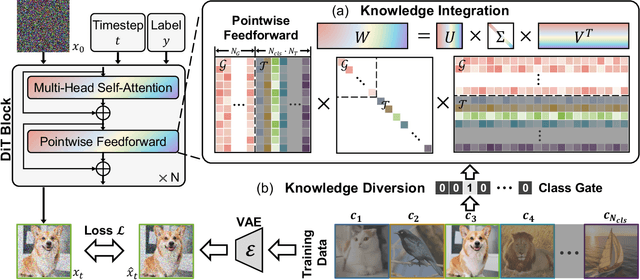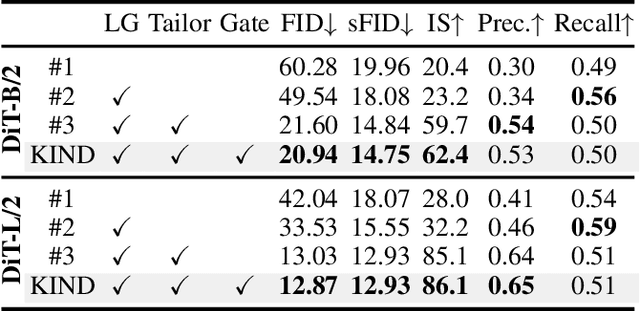Fu Feng
Redefining <Creative> in Dictionary: Towards a Enhanced Semantic Understanding of Creative Generation
Oct 31, 2024Abstract:Creativity, both in human and diffusion models, remains an inherently abstract concept; thus, simply adding "creative" to a prompt does not yield reliable semantic recognition by the model. In this work, we concretize the abstract notion of "creative" through the TP2O task, which aims to merge two unrelated concepts, and introduce CreTok, redefining "creative" as the token $\texttt{<CreTok>}$. This redefinition offers a more concrete and universally adaptable representation for concept blending. This redefinition occurs continuously, involving the repeated random sampling of text pairs with different concepts and optimizing cosine similarity between target and constant prompts. This approach enables $\texttt{<CreTok>}$ to learn a method for creative concept fusion. Extensive experiments demonstrate that the creative capability enabled by $\texttt{<CreTok>}$ substantially surpasses recent SOTA diffusion models and achieves superior creative generation. CreTok exhibits greater flexibility and reduced time overhead, as $\texttt{<CreTok>}$ can function as a universal token for any concept, facilitating creative generation without retraining.
FINE: Factorizing Knowledge for Initialization of Variable-sized Diffusion Models
Sep 28, 2024



Abstract:Diffusion models often face slow convergence, and existing efficient training techniques, such as Parameter-Efficient Fine-Tuning (PEFT), are primarily designed for fine-tuning pre-trained models. However, these methods are limited in adapting models to variable sizes for real-world deployment, where no corresponding pre-trained models exist. To address this, we introduce FINE, a method based on the Learngene framework, to initializing downstream networks leveraging pre-trained models, while considering both model sizes and task-specific requirements. FINE decomposes pre-trained knowledge into the product of matrices (i.e., $U$, $\Sigma$, and $V$), where $U$ and $V$ are shared across network blocks as ``learngenes'', and $\Sigma$ remains layer-specific. During initialization, FINE trains only $\Sigma$ using a small subset of data, while keeping the learngene parameters fixed, marking it the first approach to integrate both size and task considerations in initialization. We provide a comprehensive benchmark for learngene-based methods in image generation tasks, and extensive experiments demonstrate that FINE consistently outperforms direct pre-training, particularly for smaller models, achieving state-of-the-art results across variable model sizes. FINE also offers significant computational and storage savings, reducing training steps by approximately $3N\times$ and storage by $5\times$, where $N$ is the number of models. Additionally, FINE's adaptability to tasks yields an average performance improvement of 4.29 and 3.30 in FID and sFID across multiple downstream datasets, highlighting its versatility and efficiency.
KIND: Knowledge Integration and Diversion in Diffusion Models
Aug 14, 2024



Abstract:Pre-trained models have become the preferred backbone due to the expansion of model parameters, with techniques like Parameter-Efficient Fine-Tuning (PEFTs) typically fixing the parameters of these models. However, pre-trained models may not always be optimal, especially when there are discrepancies between training tasks and target tasks, potentially resulting in negative transfer. To address this, we introduce \textbf{KIND}, which performs \textbf{K}nowledge \textbf{IN}tegration and \textbf{D}iversion in diffusion models. KIND first integrates knowledge by decomposing parameter matrices of models using $U$, $\Sigma$, and $V$ matrices, formally inspired by singular value decomposition (SVD). Then it explicitly partitions the components of these matrices into \textbf{learngenes} and \textbf{tailors} to condense common and class-specific knowledge, respectively, through a class gate. In this way, KIND redefines traditional pre-training methods by adjusting training objectives from maximizing model performance on current tasks to condensing transferable common knowledge, leveraging the \textit{Learngene} framework. We conduct experiments on ImageNet-1K and compare KIND with PEFT and other learngene methods. Results indicate that KIND achieves state-of-the-art performance compared to other PEFT and learngene methods. Specifically, the images generated by KIND achieves more than 6.54 and 1.07 decrease in FID and sFID on DiT-L/2, utilizing only 45.4M trainable parameters and saving at least 35.4G FLOPs in computational cost.
WAVE: Weight Template for Adaptive Initialization of Variable-sized Models
Jun 25, 2024Abstract:The expansion of model parameters underscores the significance of pre-trained models; however, the constraints encountered during model deployment necessitate models of variable sizes. Consequently, the traditional pre-training and fine-tuning paradigm fails to address the initialization problem when target models are incompatible with pre-trained models. We tackle this issue from a multitasking perspective and introduce \textbf{WAVE}, which incorporates a set of shared \textbf{W}eight templates for \textbf{A}daptive initialization of \textbf{V}ariable-siz\textbf{E}d Models. During initialization, target models will initialize the corresponding weight scalers tailored to their model size, which are sufficient to learn the connection rules of weight templates based on the Kronecker product from a limited amount of data. For the construction of the weight templates, WAVE utilizes the \textit{Learngene} framework, which structurally condenses common knowledge from ancestry models into weight templates as the learngenes through knowledge distillation. This process allows the integration of pre-trained models' knowledge into structured knowledge according to the rules of weight templates. We provide a comprehensive benchmark for the learngenes, and extensive experiments demonstrate the efficacy of WAVE. The results show that WAVE achieves state-of-the-art performance when initializing models with various depth and width, and even outperforms the direct pre-training of $n$ entire models, particularly for smaller models, saving approximately $n\times$ and $5\times$ in computational and storage resources, respectively. WAVE simultaneously achieves the most efficient knowledge transfer across a series of datasets, specifically achieving an average improvement of 1.8\% and 1.2\% on 7 downstream datasets.
Transferring Core Knowledge via Learngenes
Jan 16, 2024Abstract:The pre-training paradigm fine-tunes the models trained on large-scale datasets to downstream tasks with enhanced performance. It transfers all knowledge to downstream tasks without discriminating which part is necessary or unnecessary, which may lead to negative transfer. In comparison, knowledge transfer in nature is much more efficient. When passing genetic information to descendants, ancestors encode only the essential knowledge into genes, which act as the medium. Inspired by that, we adopt a recent concept called ``learngene'' and refine its structures by mimicking the structures of natural genes. We propose the Genetic Transfer Learning (GTL) -- a framework to copy the evolutionary process of organisms into neural networks. GTL trains a population of networks, selects superior learngenes by tournaments, performs learngene mutations, and passes the learngenes to next generations. Finally, we successfully extract the learngenes of VGG11 and ResNet12. We show that the learngenes bring the descendant networks instincts and strong learning ability: with 20% parameters, the learngenes bring 12% and 16% improvements of accuracy on CIFAR-FS and miniImageNet. Besides, the learngenes have the scalability and adaptability on the downstream structure of networks and datasets. Overall, we offer a novel insight that transferring core knowledge via learngenes may be sufficient and efficient for neural networks.
Genes in Intelligent Agents
Jun 17, 2023Abstract:Training intelligent agents in Reinforcement Learning (RL) is much more time-consuming than animal learning. This is because agents learn from scratch, but animals learn with genes inherited from ancestors and are born with some innate abilities. Inspired by genes in animals, here we conceptualize the gene in intelligent agents and introduce Genetic Reinforcement Learning (GRL), a computational framework to represent, evaluate, and evolve genes (in agents). Leveraging GRL we identify genes and demonstrate several advantages of genes. First, we find that genes take the form of the fragment of agents' neural networks and can be inherited across generations. Second, we validate that genes bring better and stabler learning ability to agents, since genes condense knowledge from ancestors and bring agent with innate abilities. Third, we present evidence of Lamarckian evolution in intelligent agents. The continuous encoding of knowledge into genes across generations facilitates the evolution of genes. Overall, our work promotes a novel paradigm to train agents by incorporating genes.
 Add to Chrome
Add to Chrome Add to Firefox
Add to Firefox Add to Edge
Add to Edge